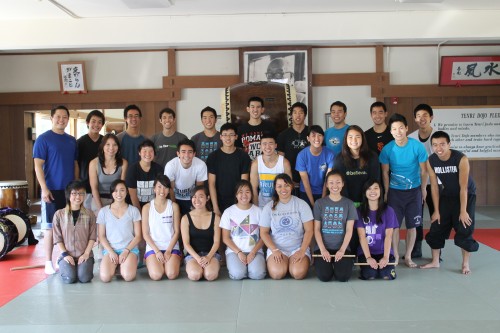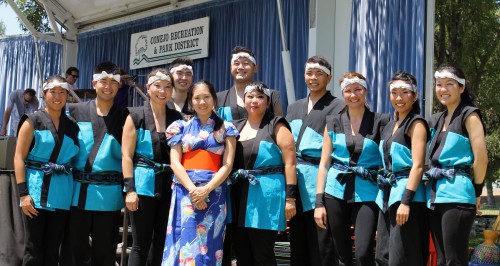Hi, everyone! My name is Keiji Uesugi, and I am the director of the taiko group Yoki Daiko, which is based at the Tenrikyo Mission Headquarters of North America in Los Angeles, California (Dendocho). Yoki Daiko is a community music group that practices and performs traditional Japanese taiko along with contemporary interpretations of this dynamic art form. Established in 1996, Yoki Daiko is comprised of members of the local Tenrikyo diocese and people who just simply love to play taiko!
In this article, I would like to address these points: The history of Yoki Daiko and its place in North American taiko; the role it plays in the Tenrikyo mission; and how it can spread the essence of the faith.
Before I can explain how Yoki Daiko came to be, it is necessary to give a brief summary on the history of taiko and its evolution in Japan and America. This will give context to why Yoki Daiko exists today.
History of the Taiko
Taiko, which means “Big Drum” in Japanese, can be traced back three to five thousand years back in Japanese history. Taiko were originally used as a form of communication between villages separated by mountains and valleys. They were also used in rituals and festivals as the base rhythm for music performed at these events. The combination of the taiko with fue, vocals, and other narimono (musical instruments) such as the kane and hyoshigi led to the creation of traditional folk music called “Hayashi.” This was basically the function of Taiko in Japanese culture for centuries: keep the rhythm together, create emphasis at certain points in music, and energize the crowd.
As post-war Japan rapidly evolved into a highly modernized society in the mid-20th century, people concerned that Japan’s rich cultural past was being replaced by westernization created organizations and conservatories to preserve Japan’s arts, such as paintings, poetry, drama, and music. Consequently, this movement reached American shores in the 1960s as taiko became a powerful means for American-born Japanese to connect with their heritage and share it with mainstream America. As taiko grew in popularity in America, so did the number of groups and interest to play by those who were not of Japanese ancestry. Today, there are over 250 taiko groups across North America and that number continues to grow with communities and university campuses continuing to start their own groups.
Beginnings of Yoki Daiko
As previously mentioned, Yoki Daiko was formed in 1996 in the mist of the excitement and enthusiasm surrounding the growth of North American taiko. In celebration of installation of the 9th Bishop at Dendocho, former Wadaiko Honjima members Marlon Okazaki and Kenny Ichikawa gathered together a group of Seinenkai (Young Men’s Association) members to learn and perform a taiko song during the entertainment portion of the event.
At that time, I was still involved with my college taiko group, Jodaiko, at UC Irvine, and helped prepare the group to perform in front of a large audience. With hard work, sore muscles, and blistery hands, the young men put on a wonderful show for the installation celebration, and thus Yoki Daiko was born. Yoki Daiko soon afterward included members of Joshi-seinen (Young Women’s Club) and Fujinkai (Women’s Association) as well. Over the next few years, the group purchased pickle barrels, cow hide, and nails to make drums, fabric was cut and sewn to make custom uniforms, and songs were added to the repertoire.
Over the years, Yoki Daiko has performed at various festivals and events all over Southern California. Occasionally, we perform at private functions and weddings where we bring a thunderous welcome to the new bride and groom.
In 2002, Yoki Daiko traveled to Japan and performed for four nights in the Oyasato Parade during Kodomo Ojibagaeri. The members were quite proud of themselves for not fainting of heat exhaustion as they performed in the hot summer nights!
Yoki Daiko Today
Currently, there are 14 members in Yoki Daiko, who all come from various backgrounds but come together every week to practice their love for taiko. The group originally started with practically all members of the Tenrikyo Church, and as Yoki Daiko’s reputation has spread, most of the members come from outside of the diocese.
Members of Yoki Daiko hold a seasonal children’s program called Chibi Taiko. Established in 2001, Chibi Taiko students learn the fundamentals of taiko and the principles of working together as one to create powerfully rhythmic music. At the end of the program, a recital is held to showcase what the children were able to accomplish.
Regarding the role Yoki Daiko plays in the Tenrikyo mission, it can be summarized within the original goals established for Yoki Daiko when it was formed:
- To gather those with a mutual interest and love for taiko.
- To nurture the youth of our diocese through taiko and develop traits of self-discipline, mutual respect, and harmony.
- To be a form of spreading the fragrance of the Tenrikyo teachings by attracting non-Tenrikyo people of all ethnicities.
- To spread joy and provide community and cultural service through taiko performances and workshops.
The last goal, “To spread joy through taiko,” is what Yoki Daiko strives for within each performance it gives in front of the audience and community. It is as an opportunity to share with others the joy and gratitude for being able to perform taiko for them. Indeed, the expression of spirited joy and thankfulness are fundamental principles in Yoki Daiko. No matter how much fun you yourself may have in playing taiko, if the people watching cannot share in that joy, then it becomes a self-serving act where the essence of playing taiko is lost.

College Workshop – this was a workshop held by Yoki Daiko for collegiate taiko players in August. Participating universities included UCLA, UCI, and UC Berkeley. (photo by Jennifer Chow)
In regard to spreading the fragrance of the faith, Yoki Daiko executes this in two ways. Yoki Daiko is always introduced as being based at the Tenrikyo Church, which creates community awareness and connection. The other way is through the group itself. I mentioned earlier that more than half the group is now comprised of members not affiliated with the diocese. Still, there is an understanding that Yoki Daiko’s foundation is with the Tenrikyo Church, and aspects of the teachings are explained.
I am always enthralled by how taiko can function as such a powerful bond to bring people together and work together toward a singular goal. It was not until I started playing with Yoki Daiko that I came to know others who had been coming to Dendocho. As Oyasama taught the importance of uniting as one, “itte hitotsu,” playing taiko requires us to listen to one another and to be unified in mind. This is what creates powerfully resonating music and what lies at the core of Yoki Daiko.
* See more Yoki Daiko videos on Keiji Uesugi’s Youtube Channel














Taiko All Day at JACCC Plaza – Rafu Shimpo
on Aug 16th, 2013
@ 4:12 am:
[…] p.m.: Yoki Daiko from Tenrikyo […]